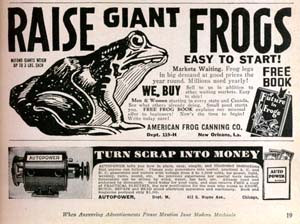
|
a weekly blog |
|
02.10.05 The World of Yesterday... Tomorrow! 3. Raise Giant Frogs! Easy to Start! Free Book! They were going to march into the Bakelite and celluloid future by answering ads, writing patent attorneys, and taking radio and television repair correspondence courses. They would send off for the Audels 4-volume Carpenters and Builders Guide for $6.00 when that was half a week's pay. They would own a Cheeze-Kist Popcorn Route so they could be their own boss, see some of Indiana, and have some more time in the workshop. They would put on their special ties, and smoke their pipes. Except for the full-color Chesterfield and Lucky Strike (green) ads on the back covers, all the ads in the magazines are for loose tobacco (Velvet, Sir Walter Raleigh, Prince Albert — "The National Joy Smoke" — for both the magazines' readers' presumed pipe habits, or the roll-you-own cigarette person's. The was at the tail-end of the Depression and many had gone to the loose-tobacco-and-papers method. High-class magazines were full of ads for "ready-mades" as cigarettes in packs were called. Most 10 cents a pack — Spuds and Wings were a nickel. And as with all Depression-era magazines, these carried money-making opportunities, only right up the handyman's alley. Assembling boats for a mail-order company is not your average envelope-stuffing come-on. There are all kinds of casting, whittling, and carpenting assembly-jobs advertised. This is in addition to the correspondence schools, pages and pages of them. Radio and television repair leads the pack, with welding, brazening, and electroplating courses not far behind. Art schools abound — remember, this was a time when magazine illustration was at its height — so was the number of magazines around. Charles Atlas was already offering you dynamic tension — if you couldn't stand that there was always Ironized Yeast tablets. There are shoe ads, and ads for traveling shoe salesmen. You could learn to play just about any musical instrument ever made (and some that had just been invented — the Tonette, sort of a plastic recorder shaped like a closed-end clarinet, so you could sound just like Jimmy Dodds on "Potatohead Blues.") You could find out how to Swing an Accordion. You could buy typewriters at 10 cents a day for a year; printing presses, auto repair libraries and tools on time payments. There are manuals on starting a poultry-raising business, mink ranches (chinchillas would be a 50s phenomenon); the ubiquitous raising of giant bullfrogs, and of "Snow King" mushrooms in your cellar (as per Ray Bradbury). You could learn anything — the future was unlimited; the Depression was the Past, and old-fashioned. We were 4-6 years into FDR's administration here; as I said, the '37 one was printed while zeppelins still flew; the last Popular Science — Dec. 1939 — came out when the war in Europe was three months old; the 1939 World's Fair (opened in May) had closed for the year (they projected a jack o'lantern face on the Perisphere on Halloween night...) The classifieds — in what looks like 3 pt type — ran an even larger gamut, from Money Making Opportunities (as opposed to Profitable Occupations) to Chalk Talk Stunt to Detectives (which are ads for correspondence school courses, not ads for typical hotel door-busters to get evidence for you) to (under Books, Magazines, Novelties Bought and Sold) "Snappy photos, books, novelties; catalog 10 cents 50 peppy comic cards $1.00" — sounds like the kind of stuff "Snappy Story" Shapley would be selling in It Happened One Night. As I said, the future was 1) up for grabs, and 2) for sale (50/$1.00). It wasn't just the Official future of the technocrats, either. It was that homemade future, where Joe Pack-A-Day could come up with something that would revolutionize some field (the Water Engine, perhaps) or a new plastic that would overhaul, say, the roofing industry. (Visions of The Man in the White Suit — 1952 — cloth that doesn't wear out, won't tear, and repels dirt — instantly 6 million more people out of work.) It was a future filled with White Science (in more ways than one...), science for the good and leisure of mankind. What is surprising is the number of military articles in these (one's by H.H. "Hap" Arnold, who later became chief of the USAAF during the war) about the dangers of close-formation bombing runs at the Muroc Army Air Corps base, and the need for new strategies — these in the Martin B-10s, a bomber so fast — for the time — that it had to slow down so its escort fighters could keep up...) The dangers of science and technology used for killing were Right There, alongside the White Science stuff — the military things were just another department, showing you what was, and what needed to be, done. Nobody questioned that a better bombsight was needed to lead to cleaners wars with only military targets being hit — not that it would lead to more and more planes on bombing runs, hence more "collateral damage", hence better anti-aircraft guns, better radar, jet planes, the A-Bomb... No one asked what a handyman with his pipe and his tie out in the shed had to do with the then unimaginable Hiroshima and Nagasaki bombs. The answer is plenty, sort of... It would be Yankee (along with the refugee German and Italian, Canadian and British) know-how that would be able to shape an explosive lens to start the chain-reactions. Somebody like David Greenglass (brother-in-law of Julius Rosenberg) raised on Popular Mechanics would run one of the machines that shaped the charges at Los Alamos. (The magazine subscription becomes the Personal and the Political.) The capacity for this Faustian duality was there in the pages — and it was hardly ever mentioned. Whatever future we would have was going to be On The Road. (As Will Rogers said, "We'll be the first nation on Earth to go to the poorhouse in an automobile.") The greatest number of straight ads are for Prestone Anti-Freeze, Dupont Zerone. Mobil "Gargoyle" Motor Oil, Genuine Ford Parts, Delco Batteries — the same ads that appeared in other magazines of the time, with no slant toward mechanics — just the common-sense general public who owned cars. (You could get a new Packard Coupe for $635.) We were coming out of the Depression (more slowly than was expected — it would take the coming of our war on December 8, 1941, to end it) — some people were back at work, there was money to be spent (for things like lumber to build furniture; metal for lamps, tools for the workshop). The mechanical-type guy, gal, and kid yearned for that future promised by The World of Tomorrow, the official theme of the 1939-1940 New York World's Fair (if you can, get the PBS documentary on it narrated by Jason Robards Jr. — it'll tell you almost everything you need to know in an hour.) There out in Flushing Meadows you'd find the Westinghouse Time Capsule, The Futurama City of 1960 — with its ten-lane highways and garden-cities; The Hall of Transportation, Electro the Robot, Television, the Trylon and Perisphere. It was a world waiting, not for the sunrise, but for the transistor.
I C London, I C France, which may be the Web's most technologically primitive blog, is brought to you through the typing, proofreading, editorial, and coding efforts of Team Waldrop, also known as Mary Kay Kare (proudly reality-based) and L. Blunt Jackson (Seattle, Philadelphia, Tau Ceti), and via the steadfast couriers of the United States Postal Service. Much thanks to all involved! Locus Magazine is offering a special deal on the issue with the superb Heart-of-Waldrop photo and interview. Che'ekidaou'ut. Howard Waldrop is a legend in his own time. He writes, he fishes, he builds bookcases. He does not have a cellphone, a computer, or an email account. For someone who is about as wired as an echidna, Howard has a pretty substantial online career. He has had a website since 1997. You can read The Ugly Chickens, The Other Real World, Winter Quarters, D = R x T, and his collaboration with Leigh Kennedy, One Horse Town, on SciFiction. Mary Margaret Roadgrader is available on the excellent Strange Horizons. He has an occasional column, Crimea River, on Electric Story. And now he has a blog. Go figure. For additional embellishments of the Waldrop legend, see Who Is Howard Waldrop, Anyway? For extravagant lies about Howard, see Alternate Waldrops, on Strange Horizons. Howard's most recent books are Custer's Last Jump and Other Collaborations and Dream Factories and Radio Pictures. Buy 'em. |
home | stories | columns | archive | faq |
Stories and articles © copyright 2001, 2002, 2003, 2004 by the original authors.
Illlustrations © copyright 2001, 2002, 2003, by the original illustrators.
Site graphics, logo, and html coding © copyright 2001, 2002, 2003, 2004 by Eileen K. Gunn.
All other material © copyright 2001, 2002, 2003, 2004 by Eileen K. Gunn.
All rights reserved.
Founding sponsor: Matrix.Net



